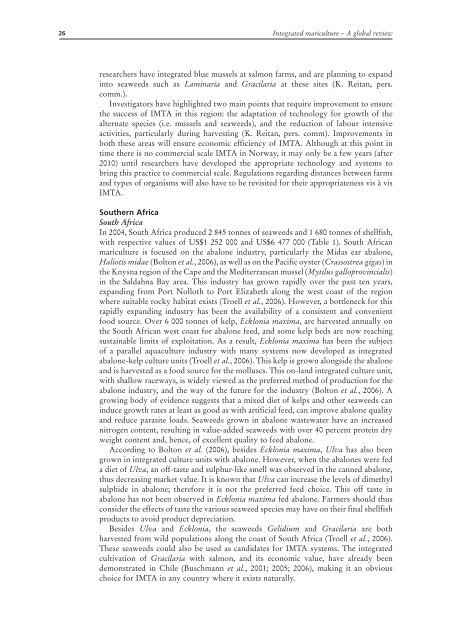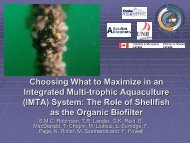Integrated multi-trophic aquaculture (IMTA) in marine temperate waters
Integrated multi-trophic aquaculture (IMTA) in marine temperate waters
Integrated multi-trophic aquaculture (IMTA) in marine temperate waters
You also want an ePaper? Increase the reach of your titles
YUMPU automatically turns print PDFs into web optimized ePapers that Google loves.
26<br />
<strong>Integrated</strong> mariculture – A global review<br />
researchers have <strong>in</strong>tegrated blue mussels at salmon farms, and are plann<strong>in</strong>g to expand<br />
<strong>in</strong>to seaweeds such as Lam<strong>in</strong>aria and Gracilaria at these sites (K. Reitan, pers.<br />
comm.).<br />
Investigators have highlighted two ma<strong>in</strong> po<strong>in</strong>ts that require improvement to ensure<br />
the success of <strong>IMTA</strong> <strong>in</strong> this region: the adaptation of technology for growth of the<br />
alternate species (i.e. mussels and seaweeds), and the reduction of labour <strong>in</strong>tensive<br />
activities, particularly dur<strong>in</strong>g harvest<strong>in</strong>g (K. Reitan, pers. comm). Improvements <strong>in</strong><br />
both these areas will ensure economic efficiency of <strong>IMTA</strong>. Although at this po<strong>in</strong>t <strong>in</strong><br />
time there is no commercial scale <strong>IMTA</strong> <strong>in</strong> Norway, it may only be a few years (after<br />
2010) until researchers have developed the appropriate technology and systems to<br />
br<strong>in</strong>g this practice to commercial scale. Regulations regard<strong>in</strong>g distances between farms<br />
and types of organisms will also have to be revisited for their appropriateness vis à vis<br />
<strong>IMTA</strong>.<br />
Southern Africa<br />
South Africa<br />
In 2004, South Africa produced 2 845 tonnes of seaweeds and 1 680 tonnes of shellfish,<br />
with respective values of US$1 252 000 and US$6 477 000 (Table 1). South African<br />
mariculture is focused on the abalone <strong>in</strong>dustry, particularly the Midas ear abalone,<br />
Haliotis midae (Bolton et al., 2006), as well as on the Pacific oyster (Crassostrea gigas) <strong>in</strong><br />
the Knysna region of the Cape and the Mediterranean mussel (Mytilus galloprov<strong>in</strong>cialis)<br />
<strong>in</strong> the Saldahna Bay area. This <strong>in</strong>dustry has grown rapidly over the past ten years,<br />
expand<strong>in</strong>g from Port Nolloth to Port Elizabeth along the west coast of the region<br />
where suitable rocky habitat exists (Troell et al., 2006). However, a bottleneck for this<br />
rapidly expand<strong>in</strong>g <strong>in</strong>dustry has been the availability of a consistent and convenient<br />
food source. Over 6 000 tonnes of kelp, Ecklonia maxima, are harvested annually on<br />
the South African west coast for abalone feed, and some kelp beds are now reach<strong>in</strong>g<br />
susta<strong>in</strong>able limits of exploitation. As a result, Ecklonia maxima has been the subject<br />
of a parallel <strong>aquaculture</strong> <strong>in</strong>dustry with many systems now developed as <strong>in</strong>tegrated<br />
abalone-kelp culture units (Troell et al., 2006). This kelp is grown alongside the abalone<br />
and is harvested as a food source for the molluscs. This on-land <strong>in</strong>tegrated culture unit,<br />
with shallow raceways, is widely viewed as the preferred method of production for the<br />
abalone <strong>in</strong>dustry, and the way of the future for the <strong>in</strong>dustry (Bolton et al., 2006). A<br />
grow<strong>in</strong>g body of evidence suggests that a mixed diet of kelps and other seaweeds can<br />
<strong>in</strong>duce growth rates at least as good as with artificial feed, can improve abalone quality<br />
and reduce parasite loads. Seaweeds grown <strong>in</strong> abalone wastewater have an <strong>in</strong>creased<br />
nitrogen content, result<strong>in</strong>g <strong>in</strong> value-added seaweeds with over 40 percent prote<strong>in</strong> dry<br />
weight content and, hence, of excellent quality to feed abalone.<br />
Accord<strong>in</strong>g to Bolton et al. (2006), besides Ecklonia maxima, Ulva has also been<br />
grown <strong>in</strong> <strong>in</strong>tegrated culture units with abalone. However, when the abalones were fed<br />
a diet of Ulva, an off-taste and sulphur-like smell was observed <strong>in</strong> the canned abalone,<br />
thus decreas<strong>in</strong>g market value. It is known that Ulva can <strong>in</strong>crease the levels of dimethyl<br />
sulphide <strong>in</strong> abalone; therefore it is not the preferred feed choice. This off taste <strong>in</strong><br />
abalone has not been observed <strong>in</strong> Ecklonia maxima fed abalone. Farmers should thus<br />
consider the effects of taste the various seaweed species may have on their f<strong>in</strong>al shellfish<br />
products to avoid product depreciation.<br />
Besides Ulva and Ecklonia, the seaweeds Gelidium and Gracilaria are both<br />
harvested from wild populations along the coast of South Africa (Troell et al., 2006).<br />
These seaweeds could also be used as candidates for <strong>IMTA</strong> systems. The <strong>in</strong>tegrated<br />
cultivation of Gracilaria with salmon, and its economic value, have already been<br />
demonstrated <strong>in</strong> Chile (Buschmann et al., 2001; 2005; 2006), mak<strong>in</strong>g it an obvious<br />
choice for <strong>IMTA</strong> <strong>in</strong> any country where it exists naturally.



